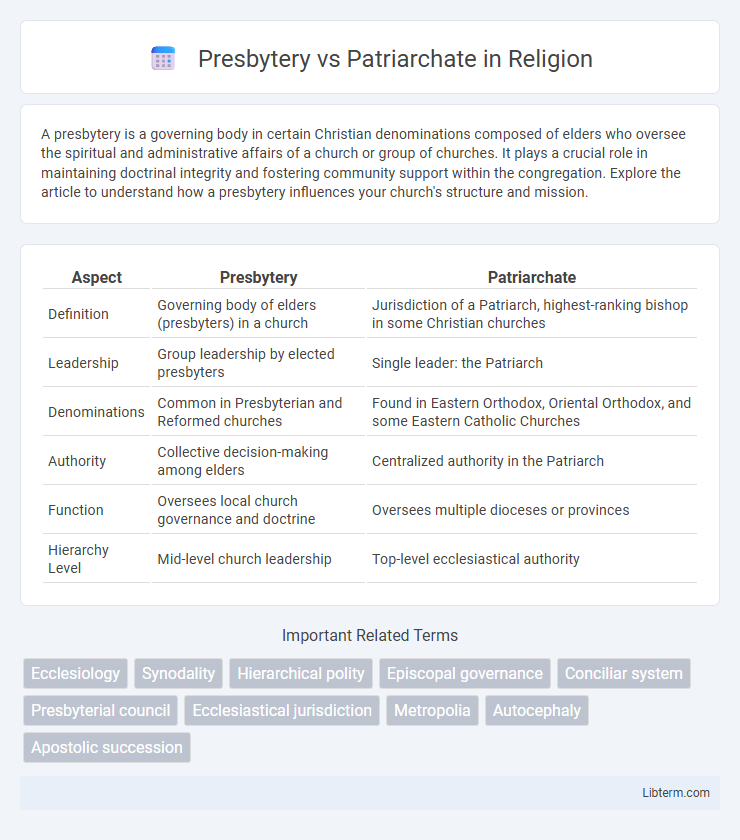A presbytery is a governing body in certain Christian denominations composed of elders who oversee the spiritual and administrative affairs of a church or group of churches. It plays a crucial role in maintaining doctrinal integrity and fostering community support within the congregation. Explore the article to understand how a presbytery influences your church's structure and mission.
Table of Comparison
| Aspect | Presbytery | Patriarchate |
|---|---|---|
| Definition | Governing body of elders (presbyters) in a church | Jurisdiction of a Patriarch, highest-ranking bishop in some Christian churches |
| Leadership | Group leadership by elected presbyters | Single leader: the Patriarch |
| Denominations | Common in Presbyterian and Reformed churches | Found in Eastern Orthodox, Oriental Orthodox, and some Eastern Catholic Churches |
| Authority | Collective decision-making among elders | Centralized authority in the Patriarch |
| Function | Oversees local church governance and doctrine | Oversees multiple dioceses or provinces |
| Hierarchy Level | Mid-level church leadership | Top-level ecclesiastical authority |
Understanding Presbytery and Patriarchate: Key Definitions
Presbytery refers to a governing body of elders in certain Christian denominations, responsible for church leadership and decision-making at the regional or local level. Patriarchate denotes the jurisdiction or office of a patriarch, a senior bishop who holds authority over multiple dioceses, typically in Eastern Orthodox, Oriental Orthodox, and some Eastern Catholic Churches. Understanding presbytery and patriarchate involves recognizing the presbytery's role in collective elder governance versus the patriarchate's hierarchical, episcopal leadership structure.
Historical Origins of Presbytery and Patriarchate
Presbytery and Patriarchate have distinct historical origins rooted in early Christian church governance. The presbytery, derived from the Greek term "presbyteros," meaning elder, emerged in the first century as a collective body of local church elders responsible for spiritual leadership and decision-making within individual congregations. In contrast, the patriarchate developed later as a hierarchical structure led by patriarchs, prominent bishops overseeing large, often metropolitan, ecclesiastical jurisdictions, with origins tracing back to the five major sees established by the Council of Chalcedon in 451 AD: Rome, Constantinople, Alexandria, Antioch, and Jerusalem.
Governance Structure: Presbytery Explained
Presbytery governance centers on a representative council of elected elders who collectively oversee the spiritual and administrative functions of a church or group of churches. This structure emphasizes shared leadership, accountability, and decision-making among presbyters, contrasting with hierarchical forms of governance. Authority is distributed across a body rather than vested in a single individual, fostering collaboration and communal oversight within Presbyterian denominations.
Patriarchate Hierarchy and Leadership Roles
A Patriarchate represents the highest ecclesiastical jurisdiction in certain Christian traditions, led by a Patriarch who holds supreme spiritual authority over multiple dioceses or provinces, often surpassing the authority of individual bishops within a presbytery. The hierarchy of a Patriarchate includes key leadership roles such as Metropolitans, Archbishops, and Bishops, all of whom report to the Patriarch and manage regional church affairs and doctrinal adherence. Unlike a presbytery, which typically governs a local group of churches through elected elders or presbyters, the Patriarchate operates as a more centralized, hierarchical institution with a clear chain of command vested in the Patriarch's leadership.
Geographic Distribution of Presbytery and Patriarchate
Presbyteries are commonly distributed throughout regions with Presbyterian forms of church governance, such as North America, Scotland, and parts of Africa, where local congregations are grouped under regional assemblies. Patriarchates are primarily found in Eastern Christianity, including the Eastern Orthodox, Oriental Orthodox, and some Eastern Catholic Churches, with notable geographic centers in Constantinople (Istanbul), Moscow, Alexandria, Antioch, and Jerusalem. The geographic distribution of patriarchates highlights historic centers of Christian authority, whereas presbyteries reflect decentralized governance structures adapted to local congregational needs across diverse regions.
Theological Differences between Presbytery and Patriarchate
Theological differences between presbytery and patriarchate primarily revolve around ecclesiastical authority and church governance. Presbytery emphasizes a collective leadership model where elders (presbyters) share equal authority within a local congregation or regional church body, reflecting a more decentralized approach rooted in Reformed theology. Patriarchate centers on hierarchical leadership under a single patriarch, reflecting apostolic succession and centralized ecclesiastical authority, characteristic of Eastern Orthodox, Oriental Orthodox, and some Eastern Catholic churches.
Influence on Local Church Communities
Presbyteries govern local church communities through councils of elected elders, emphasizing shared leadership and collective decision-making, which fosters active congregation involvement and accountability. Patriarchates exercise hierarchical authority over extensive regions, guiding theological direction and unity among multiple churches under a singular patriarch's leadership. This structure centralizes influence, often shaping liturgical practices and doctrinal stances to maintain cohesion across diverse communities.
Decision-Making Processes: A Comparative Analysis
Presbytery decision-making relies on a representative body of elders who collectively deliberate and vote on church matters, emphasizing shared governance and accountability. Patriarchate decision-making centralizes authority in a single patriarch, who holds significant spiritual and administrative power, often making final judgments on doctrinal and organizational issues. This contrast highlights presbytery's democratic approach versus patriarchate's hierarchical structure in ecclesiastical governance.
Notable Examples of Presbyteries and Patriarchates Worldwide
The Presbytery of the Church of Scotland, encompassing regional councils of elders, serves as a primary example of a presbytery system governing congregations through representative leadership. The Patriarchate of Constantinople, known as the Ecumenical Patriarchate, stands as a prominent patriarchate with significant historical and spiritual authority in Eastern Orthodoxy. Other notable patriarchates include the Patriarchate of Alexandria and the Patriarchate of Moscow, each overseeing expansive jurisdictions within the Orthodox Christian tradition.
Contemporary Relevance: Presbytery vs Patriarchate Today
In contemporary Christianity, presbyteries function as regional governing bodies within Presbyterian and Reformed churches, emphasizing collective leadership through elected elders to maintain doctrinal accountability and local church oversight. Patriarchates, primarily found in Eastern Orthodox, Oriental Orthodox, and some Eastern Catholic churches, serve as higher ecclesiastical jurisdictions led by patriarchs who combine spiritual authority with administrative governance over multiple dioceses and national churches. The ongoing relevance of presbyteries lies in their democratic church polity promoting grassroots participation, while patriarchates sustain historical continuity and centralized leadership critical for maintaining tradition and interchurch relations in diverse cultural contexts.
Presbytery Infographic

 libterm.com
libterm.com